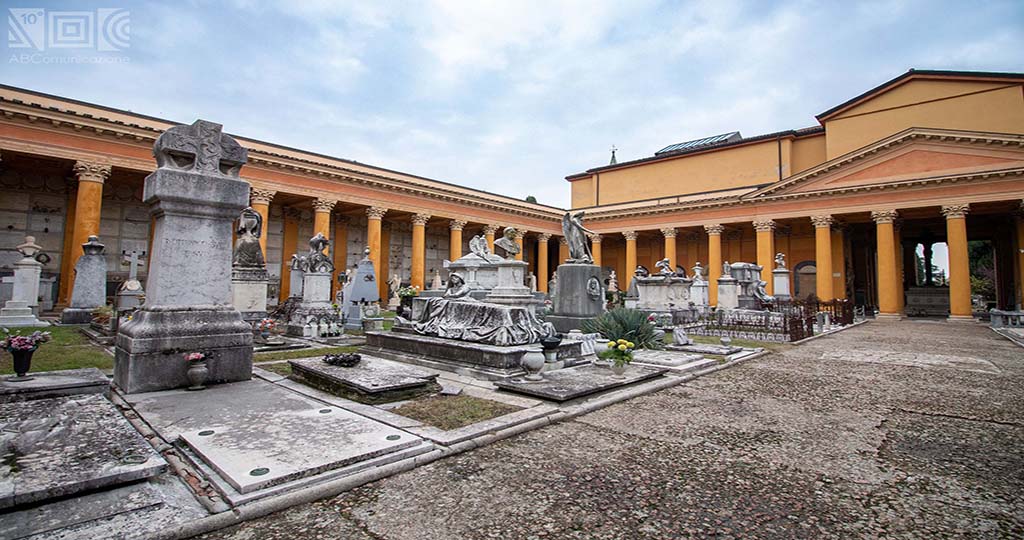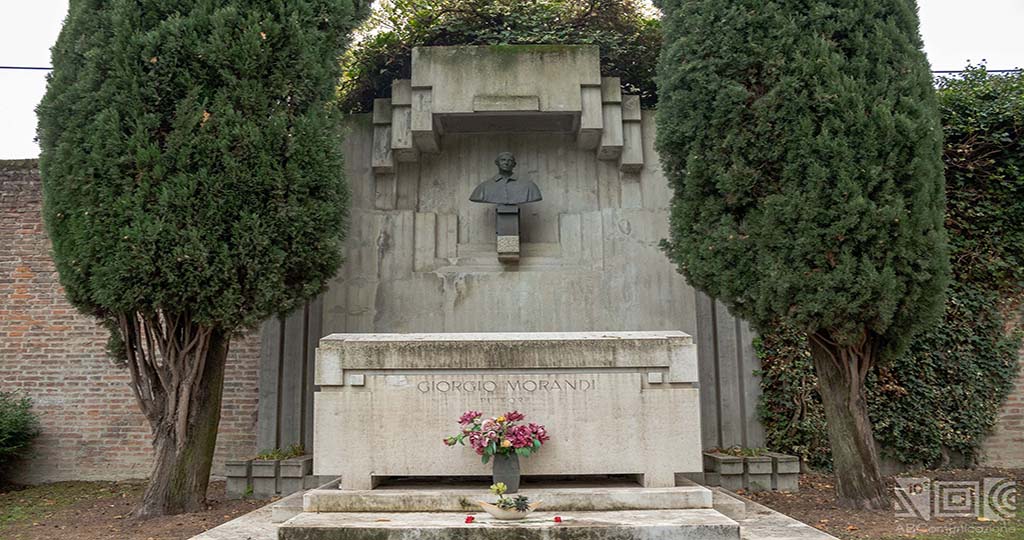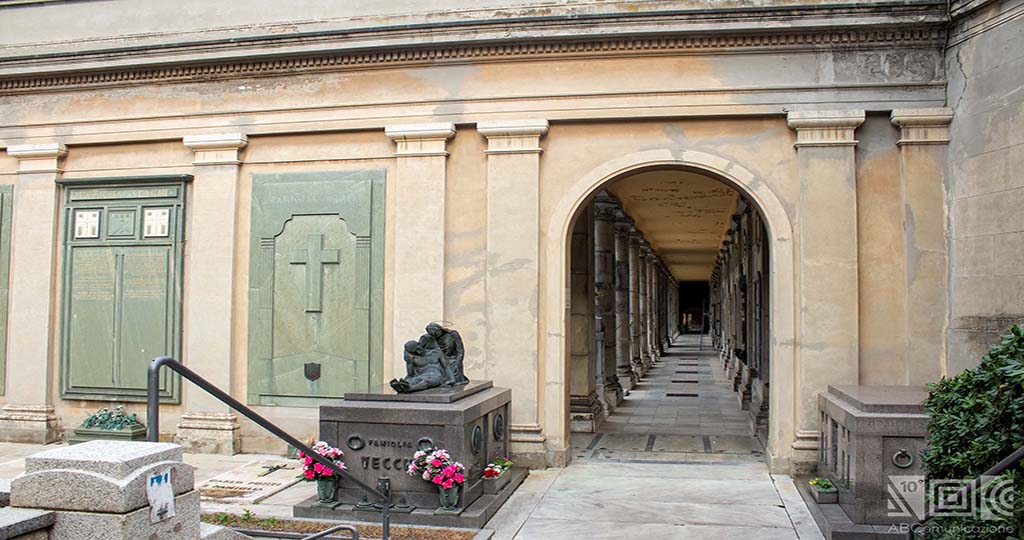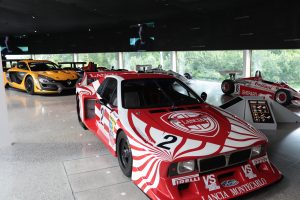The Certosa of Bologna is a unique cementery among all the graveyards of the modern necropolis of the western world.
This cemetery opened in 1801, and is the result of the transformation of an important Carthusian monastery.
The Certosa of Bologna is considered the very first Italian graveyard, since its function of offering a dignified burial to the whole city community, and not just to an élite of people.

The Certosa of Bologna: a place with a threefold value
The monumental cemetery of Bologna can be considered from three points of view.

First of all, it is here that citizens are buried and honored. Furthermore, the Certosa is also a sort of museum of contemporary funeral macaws. In fact, there are antique rooms also containing ancient monuments and tombs, that come from various churches and convents of the city, that were gradually closed or suppressed during time. Lastly, in this cemetery they still cultivate the ancient garden of Carthusians.
Origins of the Certosa cemetery
Before becoming a cemetery, for many centuries the monastery of San Girolamo of Casara has been one of the most important buildings of the city, and among the most famous monasteries of the Carthusian order. Not so far from downtown, it was beneath the hill on which there is the Sanctuary of the Madonna of San Luca.
The monastery was known and appreciated for its beautiful architecture, and for the importance of the artworks it stores in its interiors.

Its foundation dates back to the first half of the 15th century, and it also has some elements in the previous gothic style.
On the sides of the door there are many tombstones that come from various places of the city, due to the many napoleonic changes and suppressions.
The church of San Gerolamo has just one nave with three spans, and a squared apse. The cross vault has pointed arches.
The biggest chapel is square-based, and has cross vaults and costoloni. It is embellished with frescoes by Bartolomeo Cesi. In particular, we point out the Christ on the cross, Agony in the Garden, and Deposition, which compose the trilogy of the Passion.

Transformations of the Monastery
In 1796, after the arrival of the French in Bologna, the monastery was suppressed. This destiny was the same for many religious buildings: among them, we point out the Complex of San Giovanni in Monte.
In 1799, with the french administration, they banned the burials of corpses in churches, in hospitals and in the small cemeteries inside the city walls.
So, just like this, in Bologna they chose the locals of the Certosa as the suitable zone to turn into a cemetery.
This decision was linked to sanitary and economic reasons, with the goal of making the most of the areas of the city.

Following measures for the Certosa cemetery
Soon the monastery’s locations were not sufficient for all the bodies, so they added cloisters and galleries.
Lastly, in 1927 they started the construction of new areas to the west of the church.
Now, the entrances to the cemetery are three, a part from the monumental one that is now disused.
The main entrance is the one of 1768, made by Gian Giacomo Dotti, son of the constructor of the Meloncello arch and San Luca.
The second entrance dates to 1924. It is at the end of the Certosa porch, that thenn liks to the arches of San Luca at the Meloncello.
Last but not least, the third entrance is the most recent and is between Andrea Costa street and Barca street.

The Certosa porticoes
Designed by Ercole Gasparini, the Certosa portico was built between 1811 and 1831.
This construction proceeds together with the definition of a new cemeterial area.

Curiosities about the Certosa of Bologna
The transformation of the complex into a city necropolis is remembered by two stones that are positioned on the central pillar of the monumental entrance, made in 1802.
But these are not the only two marble slabs that attest the new cemetery. In fact, there are other two along the central avenue, one in front of the other. These have a latin inscription that honors the first two people that were buried here. They are Giuseppe Sarti, a baker, and Maddalena Brunini, a fifty-year-old weaver.
We cannot talk about actual tombstones, because they were not made in order to be positioned on the graves. Moreover, these are identical for dimension, shape and for the structure and style of the inscriptions.
It is very likely that they were commissioned and put together by the local authorities, in the early 19th century, so right at the beginning of the commissioning of the cemetery.

The Certosa of Bologna: a museum-graveyard
In very recent times, since 1999, the attention and cure for this place dense in history have increased significantly.
It is the story of the city itself that can reflect into the growth of the Certosa cemetery.
The transformation of the carthusian convent into graveyard in the 19th century took place thanks to the readaptation of the spaces to the new function. There has been no distortion of the previous structure.
The advent of the cemetery matches with the beginning of a new route of monumentalization. Among the first and most important projects, there is the Big Cloister, now known as Chiostro Maggiore. Also, the Cloister of the Chapel is important too, and it is now called Chiostro III.

In the various arches of these buildings they started to host the first funerary monuments, with many frescoes, made by talented artists.
During time, these arches started to host more and more graves, all characterized by the presence of a sculpture.

In addition, the rooms of the ex convent lost their original connotation and became actual rooms for the monuments. They are displayed and tend to become collections.
Other environments of the ex monastery started being adapted to the cemeterial function as well.Thus, the old cellars of carthusians, the galleries and the lodges began hosting monuments too.
A sort of museum of funerary art
The Certosa Cemetery of Bologna slowly becomes a gigantic proto-museum of funerary art.
The first private funeral monuments had frescoed walls.Then, they were gradually replaced by putty or terracotta sculptures.
Among the first artists that collaborated in this project were Pelagio Palagi and Giovanni Putti.
The funerary artworks of the Certosa continued to implement among centuries. The cemetery rapidly conquers the value of a museum.

The tomb room
This was probably the recreation room of the monks.
It has a classic vestibule with four ionic columns, and also has a part that ends with an open apse with other four columns.
It has various sarcophagi, ba-sreliefs and many busts, like the one of Malaguzzi and Macchiavelli. There is also the Bentivoglio family cellar.

The Catacombs room
The Catacombs room was designed by Luigi Marchesini. Here, there once were four cellars for monks. At the two ends there are two square-based vestibules, with four columns each, a pavilion vault and triangular wings.
The room also has many steles, graves and busts of famous people.

Who is buried at the Certosa cemetery?
Thus, the museum-cemetery of Bologna differs from the typical and traditional graveyard, usually with a big and central green area delimited by a wall or a portico.
Here you will find a set of closed spaces, lodges, cloisters and porticoes, that host the many funeral monuments, both in chalk and putty and in marble.

Over the decades the cemetery has known a progressive development, both in spacial and monumental way, with the more and more common use of marble and precious stones, of bronze, mosaics and iron work for decorations.
Numerous relevant figures of the city rest in peace in these locations.

Carducci’s monument
In front of the Cloister of the Caduti della Grande Guerra there is the monument and the crypt of Giosuè Carducci and his family. This area is also known as Campo Carducci. Its definition occurred 1935, with the collocation of the monolithic cenotaph of the poet. On it, made in granite, there is also the grave reporting his name and surname.

Giosuè Carducci was an italian poet, writer and academician. He was the first italian to win the Nobel Prize for literature in 1906. He was deeply linked to his city, Bologna, and in his compositions there are many references to the Certosa as well.
«Io alle altre città d’Italia desidero sempre Bologna, Bologna mi apre e mi promette la Certosa, la grande casa dei morti, ov’è chi mi aspetta e mi chiama e mi rimprovera e mi promette la pace».
In fact, the Carducci family had bought a modest grave thirty years before. Here, before the poet’s death, already rested his mother and three-year-old son, Dante.
After the death of the poet, in 1907, his widow decided to conserve his body in Bologna, where Carducci lived his best moments.
Then, the city wanted to increase the tribute of love for the poet, and decided to honor him with a special Campo, with his grave standing out, a part from the big monument of the Bistolfi next to his last house.
The Carducci Campo is near the new entrance of 1924.
Many are the tombs of famous people in this cemetery: among them, Giorgio Morandi and Lucio Dalla.

Dalla’s monument
Lucio Dalla was among the most important italian songwriters. Always looking for new inputs and horizons, Dalla represents the fulcrum of Italian music and Bolognese tradition.
When he died on the first of May, the Municipality of Bologna decided to give him a spot for his grave in the Certosa cemetery.
His monumental grave, made by Stefano Cantaroni and Simone Paladino, is located in the so-called “spazio Carducci”, near to other famous people, such as Carducci and Giorgio Morandi.

There is a green silhouette with written on it “musicista, poeta, maestro di vita” (“musician, poet, master of life”). The bronze statue has a silhouette of the singer, with the elements that most distinguish him: his hat, a stick and a clarinet. This scene is taken from the picture that his friend and photographer Luigi Ghirri took at the Tremiti islands. This picture is also on the album cover of Dall’America Caruso.
On his grave there is imprinted a little crown, representing the rosary that the musician always had on his finger, and a little bronze statue in the shape of a spider, remembering the nickname of the artist “Il Ragno”.
Moreover, there is the last sentence of his famous song Cara: Buonanotte anima mia, adesso spengo la luce e così sia.
Hospital Camp
The Hospital Camp has the shape of a big triangle. His main venue links the three entrances of the Certosa Cemetery, through the Carducci Campo.
Here, we can also find the Ossario dei Partigiani: a reversed cone with bronze figures that stand out, with the writing “Liberi salgono nel cielo della gloria”.

Did you know that among the partisans there were the bolognese woman Irma Bandiera? Discover her story and the ones of other women!

The Certosa cemetery and cultural events
The Institution Bologna Musei promotes many events and cultural projects that take place in the spaces of the Certosa.

In fact, it is in 1999 that the Certosa Project was born, in order to enhance and restore the big complex of the city.
Artistic, historical, theatrical and musical events compose the Summer Calendar of the Certosa. Its goal is to promote this artistic heritage: since 2021 the Certosa, together with the bolognese porticoes, became part of the Unesco World Heritage.
Read the complete programme here.

Bibliografia
- Bernabei G. (edited by), Le Meraviglie di Bologna: la Certosa, Bologna, Santarini Editore, 1993.
- Martorelli R., (edited by), Certosa di Bologna: guida, Bologna, Minerva, 2016.
- Vidor GM., Biografia di un cimitero italiano. La Certosa di Bologna, Bologna, Il Mulino, 2012.




